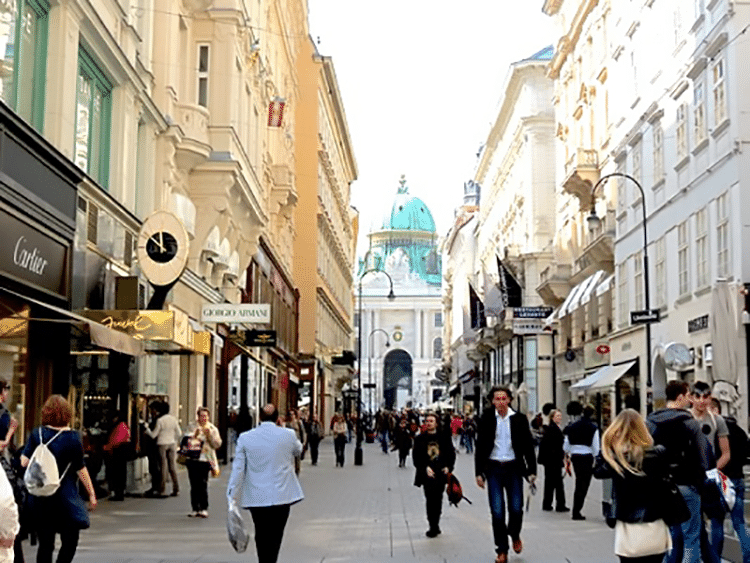The trolley car bell rings as it glides along Ringstrasse, Vienna’s grand boulevard winding around the city center in the shape of a ring. The trolley stops before Volksgarten, and I disembark to enter the majestic garden grounds. The grounds remind me of New York City’s Central Park except this park, in the heart of Vienna, is outfitted with baroque palaces, halls laden with crowns and scepters, and magnificent white stallions — the prancing, dancing Lipizzaner sort. The Volksgarten grounds, I soon discover, only hint at the full richness that is Vienna, but luckily I will get to play visiting empress for a few days and explore more.
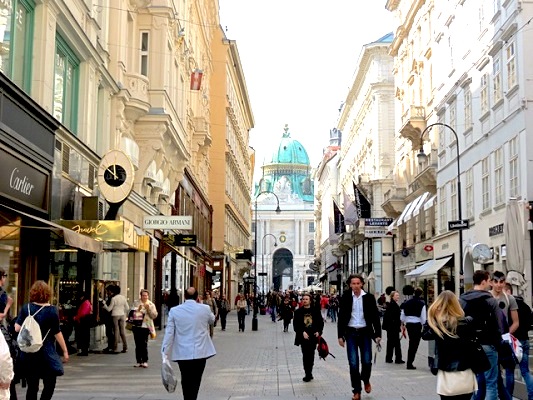
Long ago I visited a much starker Vienna, in the early ‘90s, when it seemed as though Vienna’s buildings were as grey as the dreary skies and spies lurked around every corner; the city was known as the “spy capital of the west,” given its proximity to the iron curtain and all the double dealing between east and west. Vienna, back then, was surely a setting more befitting a mystery writer than a travel writer.
Now in contrast, upon my return, the skies are gloriously bright, buildings throw off vibrant hues, and spies have apparently moved on to greyer pastures. The Vienna of today is bursting with life, color and energy, its somber grey curtain of long ago lifted, and I am not disappointed.
Ringstrasse Ring of Culture
My tour of the Vienna stage begins among the baroque buildings set in Volksgarten. I pass a life-size statue of Mozart, the flowers before his feet growing in the shape of a musical note. I am reminded that this is a city of music through and through, a city of operas and waltzes and composers like Mozart, Strauss and Beethoven to name a few. Perhaps they too strolled the Volksgarten grounds, which plays host to an enormous complex of baroque palace structures that once served as the summer residence of the imperial Hapsburg dynasty. Now, various buildings house museums including one featuring the chivalry and armor of knights. My favorite museum is the Imperial Treasury, which holds one of the world’s most noteworthy noble collections. Between its storied walls, I find riches that literally take my breath away: the Emperor’s crown of the Holy Roman Empire (circa 962); a sabre from the court of Charlemagne; ermine-trimmed robes of Knights of the Order of the Golden Fleece. I half expect to see Lancelot emerge from the shadows. I admire an amethyst the size of an egg and an astounding spiraling “unicorn” horn (likely from a narwhal). I’ve never seen riches that compare to this Treasury, its displays dazzling both in terms of their historic context — and exorbitant value.
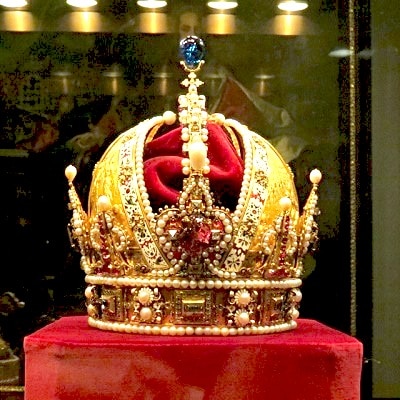
Prancing Lipizzaner Stallions
Rich in historic significance is also the Spanish Riding School just a few royal arches away from the Treasury. There, from the hours of 10 to noon each morning, visitors can pay admittance to view the training of noble Lipizzaner stallions (guests are permitted to enter at their leisure, space permitting). There are formal shows, but these exercise sessions are an easy way to sample what the stallions are all about. I watch some prance in a sideways maneuver, unnatural for a horse — but these are not just any horses. Then I observe an especially tricky maneuver, a “courbette.” It can take years to discover if a horse has a talent for this display, which involves the stallion rearing on its hind legs, then jumping several times without lowering its forelegs, a near-herculean endeavor for a four-legged creature and one that the crowd heartily applauds.
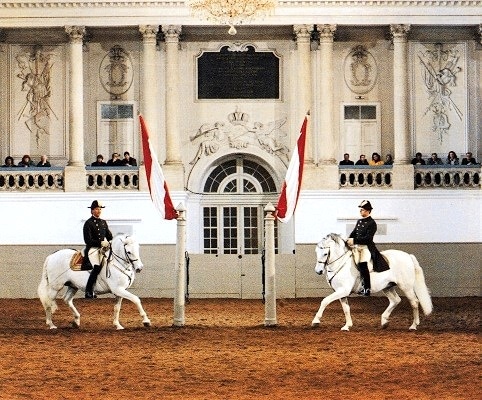
Beyond the confines of the Lipizzaner arena, just outside the palace complex, are exposed Roman ruins, a reminder of the ancient heritage of this storied city. In fact, the Danube River in Vienna represents the most northernmost point that the tentacles of the Roman Empire reached, the Romans considering anything further as “barbarian” territory. The environs of Vienna are anything but as I stroll the bustling grounds surrounding the palace area. Locals and tourists gather at the Palmenhaus restaurant, their profiles framed by the brilliant glass dome of a soaring greenhouse. Bicyclists peddle by. Flowers are blooming at every turn.
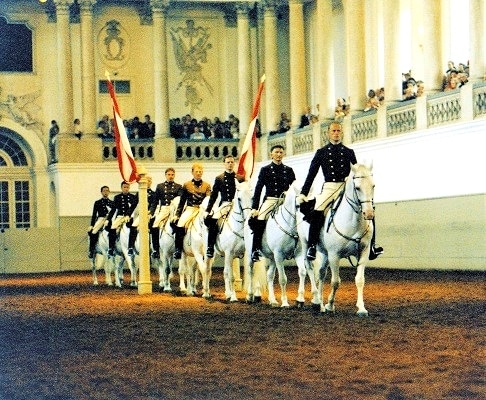
This palace complex is only part of Vienna’s royal ring, which also features the parliament building, the Opera House, museum of fine arts, and much more. Vienna is geographically defined by districts that chronologically circle the center like a snail’s shell, beginning with the Ringstrasse and Volksgarten area in District 1, ranging up to District 9 for the general city center area, and concentrically expanding up to District 23 and the further reaches of Vienna. It’s District 1, however, where Vienna pulsates. As my guide, Beatrice, says about that area, “If you are bored, it’s your own fault.”
Coffeehouse Culture
Not to be faulted, I continue my Vienna stage show, and if there is a must in Vienna, beside its plethora of requisite museums, it is to relish the coffeehouse culture. I sit on the ornate swirls of a red-and-cream colored upholstered banquette at Café Sperl. I learn from the proprietor, Manfred Staub, what makes a Viennese coffee shop so special and why the city’s coffee house culture was deemed an “intangible” UNESCO heritage site in 2011. Café Sperl maintains decor as though from the 1880’s, he explains. Marble tabletops are decked with iron feet. Overhead lamps retain a style unaltered from when they were gas-operated (now they’re electric). Servers are dressed in black and white. Billiard tables overflow with periodicals so that guests such as literati, painters, and composers can wile away the hours over desserts and coffees; mélange a Viennese favorite among the latter — mocha offset with foamed milk and traditionally accompanied by a glass of water.
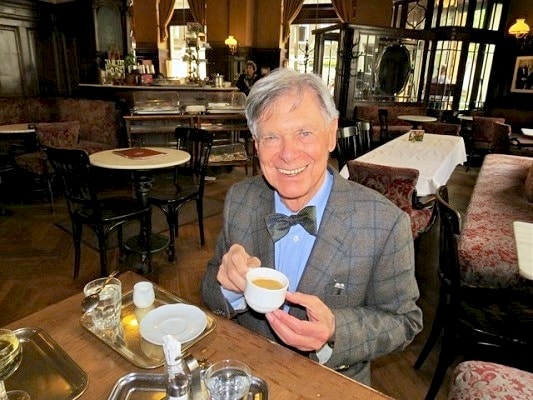
Vienna’s coffeehouse culture is about atmosphere, or “the whole package,” as Staub says, and it’s about tradition. Well, except for Wi-Fi. Of that, Staub’s wife Monica says, “We shouldn’t have done it.” But there you have it, the wired Vienna of today. After feasting on Monica’s recommendation for “diet food,” i.e. a decadent dessert made with chocolate, sugar and hazelnut but without flour, hence “diet food,” it is time to walk off my café visit.
I head to the Leopold Museum to glimpse its Gustav Klimt masterpieces and Austrian modernism. The museum houses a bold collection of important works gathered over five decades by Rudolf and Elisabeth Leopold and is the most visited museum in Vienna’s MuseumsQuartier. Formerly the royal stables, the MuseumsQuartier is now a museum block, opened in 2001, with popular outdoor gathering spaces filled with cafés and shops. I then stroll Vienna’s busy promenades, past the Opera House where kings and queens have watched Don Giovanni, pleasured in Mozart, and waltzed at the New Year’s Ball. When my feet tire, the bell of the trolley car rescues me, the D line going round the ring boulevard for perhaps the easiest touring route I can imagine a city having.
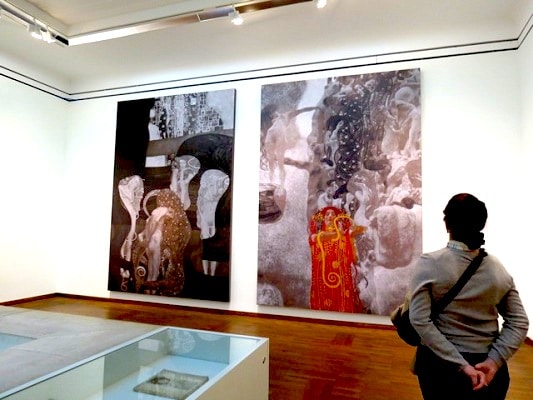
On a subsequent day, that same D line takes me further afield, to the “Arsenal” as some call it, otherwise known as the military museum. It’s a fascinating change of pace after viewing so many hanging portraits. Here, my ears perk up to the sound of World War II stories, and my sights are intrigued by the large variety of memorabilia including military uniforms, rifles, gas masks, tanks galore and more. The museum has a WWI section as well, along with exhibits on Austria’s naval history.
A stone’s throw from this specialty museum is yet another Austrian palace, the Winter Palace or Belvedere Palace. Set amid beautiful sprawling grounds, there is an upper palace and lower palace, both of which are museums featuring fine art with formal gardens separating the two structures. The grounds and its outdoor cafe make for a pleasant escape from the bustling city center, and though I’m only in District 5, a mere 15 minutes from the city center, I feel worlds removed.
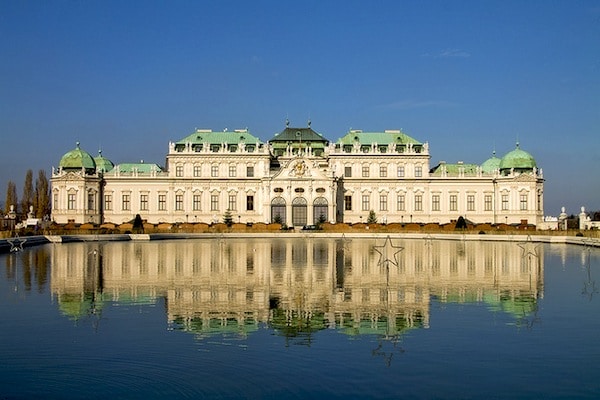
Between visiting all of these palaces, museums, gardens and cafes, I also find time to indulge in local delicacies like traditional Wiener schnitzel and local vintages from vineyards to the northwest of Vienna. All the while, I consider how the omnipresent sounds of operettas seem to waft on the wings of Vienna’s winds. There’s not a spy in sight as I wrap up my viewing of this modern stage show in Vienna — but then, one never knows what might lurk around the next corner in this beautiful city so full of surprises.
The country code for Austria is 43. The Vienna city code is 1.
Where to Stay:
Best Western Harmonie – A four-star boutique hotel in an elegantly refurbished classic building. Situated in a trendy residential quarter and convenient to the trolley for reaching major attractions. Harmoniegasse 5-7, Vienna; 317 66 04;www.harmonie-vienna.at
Hotel Imperial – Sleeping at its grandest in a former palace along Ringstrasse, close to the Opera House. Kärntner Ring 16; Vienna; 501 100, from the U.S. 800-325-3589;www.imperialvienna.com
Where to Eat:
Café Sperl – As classic as a Viennese coffeehouse gets. Legendary for its atmosphere and patrons. Gumerndorfer Strasse 11, 6th District; 586-41-58; www.cafesperl.at
Palmenhaus – Brasserie that includes outdoor terrace seating. Architecturally part of an enormous greenhouse/butterfly house set amid the central Hofburg palace gardens. Burggarten 1; 533-10-33; www.palmenhaus.at
Bistro Menagerie – This Belvedere Palace bistro offers a pretty garden café setting in spring/summer for light meals and Viennese desserts. Prinz Eugen-Str. 27; 795-57-0; www.belvedere.at
Any places that serves Wiener Schnitzel – A classic Viennese specialty and Austrian national dish of breaded and fried veal escalope. No visit to Vienna is complete without it. Usually served with parsley-tossed potatoes.
What to Do:
Imperial Treasury (Kaiserliche-Schatskammer Wien) – This medieval section of the Hofburg Palace houses a spectacular and historically significant collection of royal treasures. Hofburg, Schweizerhof, 525-24-0, www.kaiserliche-schatzkammer.at
Leopold Museum – An architecturally beautiful museum featuring important works of Austrian modernism and expressionism including major Gustav Klimt and Egon Schiele works. Museumplatz 1, MuseumsQuartier; 525-70-1507; www.leopoldmusuem.org
Spanish Riding School (Spanische Hofreitschule) – Lipizzaner horses and riders display classic Renaissance form in an elegant tradition that spans over 400 years. Performed in a baroque riding hall, Michaelerplatz 1; 533-90-31, www.srs.at
Waltz at a Ball – Vienna hosts more than 450 balls annually, and the city is synonymous with the Viennese waltz. Le Grand Bal is the season opener on New Year’s Eve at the Hofburg Palace, Heldenplatz; 587 36 66 23; www.legrandbal.at
How to Get There:
Austrian Air offers non-stop flights to Vienna from major U.S. cities.

